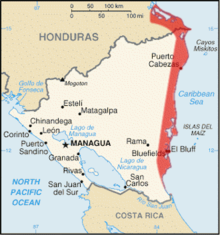Miskito Coast
The term Miskito coast (after the indigenous people of the Miskito , German and Miskito Indians or Mosquito Indians named, but Spanish: Costa de los Mosquitos = Mosquito coast ), or mosquito coast (formerly Mosquito Coast written and sometimes Mosquitia called) pointed particularly during During the colonial period, the Caribbean coast of Nicaragua , which, like Belize , was dominated by Great Britain in large parts .
Geographical demarcation
Although the name was used by some authors for the entire east coast of Nicaragua up to the Río Negro or the Río Tinto and in some cases even included La Mosquitia , today's northeastern Honduras, the actual term referred to a narrow strip along the Caribbean coast of 11 ° 45 'to 14 ° 10' N, which extends over an average width of approx. 60–70 km and approx. 360 km in length from the Río Wawa in the north to the Río Rama in the south. The eastern edge of the Nicaraguan highlands forms the western boundary on the mainland.
population
The Miskito Coast is named after the majority of its inhabitants, the Miskito Indígena . In addition to the Miskito, the small tribes of Sumo and Rama also live on the local coast. The Miskito are small in stature and have darker, reddish-brown skin. Because of their skin color, it was assumed that they were descendants of black slaves and indigenous people who had fled from shipwrecks . They speak a Chibcha language and move in their boats on the rivers of the rainforest along the extensive Caribbean coast, also across the border to Honduras.
history
Historically the most important place was a pirate settlement and later port city on the Caribbean coast, which was named Bluefields in 1601 after the Dutch privateer Bleeveldt . As the largest settlement along the Miskito coast with a good port, it served as the capital.
In 1604 Spanish conquistadors invaded the north and east of Nicaragua from Peru , into the areas of the Xicaque and the ancestors of the Miskito Indians. The coast first became part of the Viceroyalty of Peru . The first English settlers settled on the Miskito coast in 1630. They were agents of the English Providence Island Company , where Robert Rich, 2nd Earl of Warwick was chairman and John Pym treasurer, occupied two small sandbanks and maintained friendly relations with the indigenous people.
Between 1655 and 1850 England claimed a protectorate over the Miskito coast, corrupted in "Mosquitia". The English governor of Jamaica crowned the first Miskito king in 1687. However, the British did not exercise central state power. The Miskito village communities remained independent, were not deported by the English, and other indigenous groups between the Yucatán and Panamá were temporarily liable for tribute to the Miskito. From 1740 the British flag fluttered over Bluefields.
The Moravian Church, in German the Moravian Brethren , began its missionary work in Bluefields in 1847. By the end of the 19th century, the Pietist Brethren from Herrnhut, Saxony, had Christianized almost all indigenous and Afro-American Creoles on the Caribbean coast.
In addition to the viceroyalty of New Granada , which split off from Peru in 1739 and whose claims were later taken over by the Central American republics, the USA also raised claims to the coast. Their demands were based not least on fears of a privileged position that Britain might have taken with regard to the proposed inter-oceanic Nicaragua Canal . In 1848 the occupation of Greytown , today's San Juan del Norte , by Miskito indigenous people with British help raised the risk of war.
In the Clayton Bulwer Treaty of 1850, both powers undertook not to colonize or occupy any part of Central America and granted each other the exclusive right to build the Nicaragua Canal. In 1859 Great Britain ceded its protectorate to Honduras . This aroused great discontent among the indigenous population. Only on January 28, 1860, Nicaragua and Great Britain formally subordinated the Miskito coast from Cabo Gracias a Dios to Greytown to the sovereignty of Nicaragua in the Treaty of Managua and assured the Miskito internal autonomy . The head of the Misikito accepted the change in circumstances, which limited his authority to local affairs, for an annual allowance of £ 1000 until 1870. But his successor in 1864 refused to accept it.
The self-determination of the Miskito within the Nicaraguan Republic was reaffirmed in an arbitration award by Emperor Franz Joseph I in 1881 . Trade and exploitation of natural resources should be under the control of the Miskito government. North American companies began to plant extensive banana plantations on the Miskito Coast in 1882 . By the turn of the century, they managed to gain control of almost all of the area's trade.
But after 14 years of complete autonomy, this was repealed by its then President, General José Santos Zelaya . With the “Decree of Reintegration” of the Miskito coast, he had General Cabezas occupy it militarily in 1894. The Nicaraguan Department of Zelaya emerged from the Miskito coast. In the meantime, autonomy has been restored. The autonomous areas Costa Caribe Norte and Costa Caribe Sur now exist on the former Miskito coast .
literature
- Julius Richter : The dispute over the Mosquito coast . In: Journal of the Society for Geography , vol. 30 (1895), pp. 498–501.
- Wolfgang Gabbert: Creoles. African Americans in the Caribbean lowlands of Nicaragua . Lit-Verlag, Münster & Hamburg, 1991, ISBN 3-89473-191-5 .



